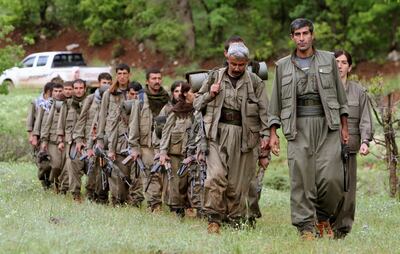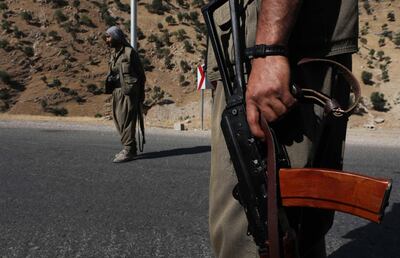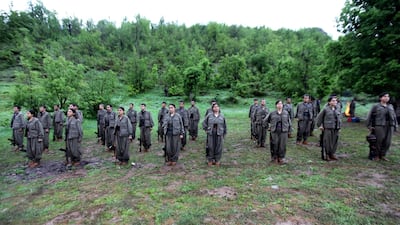The leader of the separatist Kurdistan Workers Party (PKK) Abdullah Ocalan called on his followers to disarm, possibly ending more than four decades of insurgency against the Turkish state that has caused the deaths of about 40,000 people.
The PKK has said it could end its armed rebellion several times in the past under the right conditions.
Murat Karayilan, the head of the armed wing, once promised that “arms can be abandoned at the end of a specific process, if the Turkish state clears the way for the democratic struggle of the Kurdish nation, if it ceases to continue its policies of denial, arms may lose their meaning.”
But just where did the group get those arms, enabling it to mount such a potent insurgency for so long? Many insurgent groups like the PKK often lack sustained foreign backing and turn to crime and extortion for funds.
In the past, the PKK has received arms from Syria, Armenia and Iran, but shifting political currents have undermined those weapons transfers.
In some instances, the group has even made its own guns, like the large calibre, long range Zagros rifle. The weapon has also been used by the US-backed People's Protection Units (YPG) part of the Syrian Democratic Forces, the US' main ally in the war against ISIS in Syria. The use of the gun by both groups has fuelled long-standing Turkish accusations that the YPG and PKK closely co-operate, despite US claims to the contrary.
Karayilan, also known as Cemal, was designated a “Significant Foreign Narcotics Trafficker,” by the US Treasury in 2008, and subject to a $5 million bounty.
Drug running on a massive scale was one way the group could maintain a supply of arms and funding after Baathist Syria - formerly one of the group’s main backers - expelled Ocalan in 1998 under Turkish pressure, the year of his arrest and a unilaterally declared PKK ceasefire.
Weeks after the ceasefire ended, another Kurdish separatist group, the Kurdistan Freedom Falcons, launched a bombing campaign which would soon target tourist areas and public transport.
This was a low point for the PKK, following harsh and often bloody Turkish government crackdowns in Kurdish majority areas, widely condemned by human rights groups.
Over the years, the PKK has been able to recruit and raise funds during these periods of oppression and chaotic episodes in the region’s history, building an arsenal of weapons, often hidden in mountain hideouts, including some of the oldest guns in service.
Syria's collapse
Some of their weapons date to the Second World War or earlier, but include modern weapons, including deadly first-person view drones, shoulder-launched anti-aircraft weapons and Russian anti-tank weapons such as the Konkurs, likely to have come from former Syrian army stocks.
SA-18 and SA-7 portable anti-aircraft systems have also been used to shoot down Turkish helicopters, almost certainly from Syrian stocks (originally purchased from Russia) or obtained during Syria’s collapse into civil war after 2011.
One 2017 Turkish raid on a major PKK weapons cache in the mountains of southern Turkey illustrates the issue well. The army said they had found “237” of the ubiquitous Kalashnikov assault rifle, 23 G-3 rifles, a Zagros rifle, several Mauser rifles and an M-16, among other weapons.
The Soviet-era Kalashnikovs are the easiest to explain, for decades the standard-issue rifle of the Syrian army with many different variants made in around 20 countries, and an estimated 100 million manufactured worldwide. But just how old are some of the PKK’s Kalashnikovs?
According to Militant Wire, a website dedicated to tracking arms, PKK fighters have recently been spotted with AK-74s from 1981, three years after the gun, a successor to the AK-47, entered service.
It’s likely that many of the Kalashnikovs used by the group are far older, if some of the other rifles are a guide. No model for the Mausers is mentioned in the Turkish statement, but the German company made the standard issue rifle for the Nazis and, after the Second World War, revived operations in the 1960s making sniper rifles, until it was purchased by Rheinmetall in 1995.
It is possible the guns found could have been Second World War era because Militant Wire notes, the PKK has used heavily modified Mosin-Nagant rifles.
The Mosin-Nagant, developed over a century ago in Russia, was widely used by the Soviet Army in the 1930s and 40s and, like the Mauser, made its way to Baathist Syria in the 1950s and 60s when Damascus was closely aligned to the Communist Bloc. Mosin-Nagants with new barrels and modern sights have often been seen in the Syrian civil war, along with other Second World War weapons likely transferred from Eastern Germany or Communist Czechoslovakia.
The G-3 rifles, made by German firm Heckler & Koch, may have been weapons made under licence by Iran, which at times has been a supporter of the PKK, backing the Iraqi Kurdish Patriotic Union of Kurdistan, which at times worked with the PKK. Turkey suspects Iran may still be attempting to equip the PKK, possibly supplying 358 loitering munitions, a type of missile designed to hunt down enemy helicopters and drones.
Finally, the M-16 might have been captured from Turkish forces, which over the decades have been heavily equipped with American weaponry or, might have been purchased on the black market after tens of thousands of arms supplied by the US to the Iraqi army after the 2003 US invasion disappeared.
Those included many M-16s abandoned by Iraqi forces crumbling in the face of militant insurgents or soldiers who simply left the army and sold their rifles for additional income.
This class of US-purchased weapons could extend to AT-4 anti-tank weapons, supplied to Kurdish Peshmerga and Iraqi forces during the war against ISIS, and captured from the PKK in Turkish operations.
FIXTURES
All times UAE ( 4 GMT)
Friday
Saint-Etienne v Montpellier (10.45pm)
Saturday
Monaco v Caen (7pm)
Amiens v Bordeaux (10pm)
Angers v Toulouse (10pm)
Metz v Dijon (10pm)
Nantes v Guingamp (10pm)
Rennes v Lille (10pm)
Sunday
Nice v Strasbourg (5pm)
Troyes v Lyon (7pm)
Marseille v Paris Saint-Germain (11pm)
White hydrogen: Naturally occurring hydrogen
Chromite: Hard, metallic mineral containing iron oxide and chromium oxide
Ultramafic rocks: Dark-coloured rocks rich in magnesium or iron with very low silica content
Ophiolite: A section of the earth’s crust, which is oceanic in nature that has since been uplifted and exposed on land
Olivine: A commonly occurring magnesium iron silicate mineral that derives its name for its olive-green yellow-green colour
Our family matters legal consultant
Name: Hassan Mohsen Elhais
Position: legal consultant with Al Rowaad Advocates and Legal Consultants.
RedCrow Intelligence Company Profile
Started: 2016
Founders: Hussein Nasser Eddin, Laila Akel, Tayeb Akel
Based: Ramallah, Palestine
Sector: Technology, Security
# of staff: 13
Investment: $745,000
Investors: Palestine’s Ibtikar Fund, Abu Dhabi’s Gothams and angel investors
On racial profiling at airports
Lexus LX700h specs
Engine: 3.4-litre twin-turbo V6 plus supplementary electric motor
Power: 464hp at 5,200rpm
Torque: 790Nm from 2,000-3,600rpm
Transmission: 10-speed auto
Fuel consumption: 11.7L/100km
On sale: Now
Price: From Dh590,000
The specS: 2018 Toyota Camry
Price: base / as tested: Dh91,000 / Dh114,000
Engine: 3.5-litre V6
Gearbox: Eight-speed automatic
Power: 298hp @ 6,600rpm
Torque: 356Nm @ 4,700rpm
Fuel economy, combined: 7.0L / 100km
COMPANY%20PROFILE
%3Cp%3E%3Cstrong%3ECompany%3A%3C%2Fstrong%3E%20Sideup%3Cbr%3E%3Cstrong%3EStarted%3A%3C%2Fstrong%3E%202019%3Cbr%3E%3Cstrong%3EFounder%3A%3C%2Fstrong%3E%20Waleed%20Rashed%3Cbr%3E%3Cstrong%3EBased%3A%3C%2Fstrong%3E%20Cairo%2C%20Egypt%3Cbr%3E%3Cstrong%3EIndustry%3A%3C%2Fstrong%3E%20technology%2C%20e-commerce%3Cbr%3E%3Cstrong%3EFunds%20raised%20so%20far%3A%3C%2Fstrong%3E%20%241.2%20million%3Cbr%3E%3Cstrong%3EInvestors%3A%3C%2Fstrong%3E%20Launch%20Africa%20VC%2C%20500%20Global%2C%20Riyadh%20Angels%2C%20Alex%20Angels%2C%20Al%20Tuwaijri%20Fund%20and%20Saudi%20angel%20investor%20Faisal%20Al%20Abdulsalam%3C%2Fp%3E%0A
More coverage from the Future Forum
Zombieland: Double Tap
Director: Ruben Fleischer
Stars: Woody Harrelson, Jesse Eisenberg, Emma Stone
Four out of five stars
UAE currency: the story behind the money in your pockets
Real estate tokenisation project
Dubai launched the pilot phase of its real estate tokenisation project last month.
The initiative focuses on converting real estate assets into digital tokens recorded on blockchain technology and helps in streamlining the process of buying, selling and investing, the Dubai Land Department said.
Dubai’s real estate tokenisation market is projected to reach Dh60 billion ($16.33 billion) by 2033, representing 7 per cent of the emirate’s total property transactions, according to the DLD.
MATCH INFO
Manchester United 1 (Fernandes pen 2') Tottenham Hotspur 6 (Ndombele 4', Son 7' & 37' Kane (30' & pen 79, Aurier 51')
Man of the match Son Heung-min (Tottenham)
<html><head><meta http-equiv="Content-Type" content="text/html" charset="UTF-8" /></head><body><!--PSTYLE=* Labels%3aFH Label 18 Sport--><p>Beach soccer</p><!--PSTYLE=BY Byline--><p>Amith Passela</p><p /></body></html>
More on Quran memorisation:
From Zero
Artist: Linkin Park
Label: Warner Records
Number of tracks: 11
Rating: 4/5
ELIO
Starring: Yonas Kibreab, Zoe Saldana, Brad Garrett
Directors: Madeline Sharafian, Domee Shi, Adrian Molina
Rating: 4/5
Company profile
Name: Thndr
Started: October 2020
Founders: Ahmad Hammouda and Seif Amr
Based: Cairo, Egypt
Sector: FinTech
Initial investment: pre-seed of $800,000
Funding stage: series A; $20 million
Investors: Tiger Global, Beco Capital, Prosus Ventures, Y Combinator, Global Ventures, Abdul Latif Jameel, Endure Capital, 4DX Ventures, Plus VC, Rabacap and MSA Capital
The specs
Engine: 4.0-litre V8 twin-turbocharged and three electric motors
Power: Combined output 920hp
Torque: 730Nm at 4,000-7,000rpm
Transmission: 8-speed dual-clutch automatic
Fuel consumption: 11.2L/100km
On sale: Now, deliveries expected later in 2025
Price: expected to start at Dh1,432,000
What is blockchain?
Blockchain is a form of distributed ledger technology, a digital system in which data is recorded across multiple places at the same time. Unlike traditional databases, DLTs have no central administrator or centralised data storage. They are transparent because the data is visible and, because they are automatically replicated and impossible to be tampered with, they are secure.
The main difference between blockchain and other forms of DLT is the way data is stored as ‘blocks’ – new transactions are added to the existing ‘chain’ of past transactions, hence the name ‘blockchain’. It is impossible to delete or modify information on the chain due to the replication of blocks across various locations.
Blockchain is mostly associated with cryptocurrency Bitcoin. Due to the inability to tamper with transactions, advocates say this makes the currency more secure and safer than traditional systems. It is maintained by a network of people referred to as ‘miners’, who receive rewards for solving complex mathematical equations that enable transactions to go through.
However, one of the major problems that has come to light has been the presence of illicit material buried in the Bitcoin blockchain, linking it to the dark web.
Other blockchain platforms can offer things like smart contracts, which are automatically implemented when specific conditions from all interested parties are reached, cutting the time involved and the risk of mistakes. Another use could be storing medical records, as patients can be confident their information cannot be changed. The technology can also be used in supply chains, voting and has the potential to used for storing property records.
UAE currency: the story behind the money in your pockets




